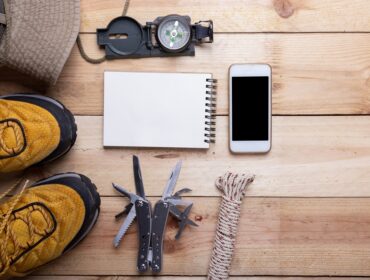This is the last of a two-part series on choosing, preparing, and cooking with a dutch oven.
Your dutch oven is seasoned, your camping menu is planned, all that remains is to learn how to use it. Yes, there actually is a technique!
Turning Up the Heat
A dutch oven can be used as an open or closed vessel for cooking, but if you are using it as a closed oven, the coal appropriation is important. While recipes will have varying instructions for the amount of coals, a good rule of thumb is to multiply the size of your dutch oven by two to get the number of coals you’ll use (12″ x 2 = 24 coals). Then, divide the coals again: 1/3 of the coals on bottom, 2/3 of the coals on top, evenly spaced. This will ensure you get a nice even heat going inside the dutch oven that will cook your meal just like an oven at home.
As far as cooking times go, you can generally go by what the cooking time would be at home, less a few minutes, as the mean temperature obtained by using the above coal placement method is around 350 degrees Fahrenheit. If a cake takes 30 minutes to bake at home, you can probably begin checking your dutch oven cake at around 20 minutes. Like other cooking skills, timing is one that will be learned with practice.
Many dutch oven cooks own charcoal chimneys, which prepares the charcoal in a metal container that keeps the heat concentrated on the coals, rather than being blown around in a fire pit. This is completely optional, but it does help with distribution if your coals are all a relatively uniform shape, rather than chunks of all sizes, and using charcoal briquettes is a great way to accomplish this. You will definitely want to purchase a lid lifter, a long metal pole with a hook on the end, to properly remove the lid and pot from the coals without getting burned.

Get Cooking
With every meal you make in your dutch oven, you are constantly seasoning it, replenishing that essential non-stick coating that helps your food cook evenly and release from the pan easily, but some dutch oven cooks are fans of using parchment paper. Whether you’re baking a lasagna or cake, or anything particularly messy, parchment paper is an excellent choice for meals that leave little mess behind, and the paper can simply be burned when finished.
Don’t be afraid to try making recipes you would ordinarily make in a traditional oven — that’s the beauty of the dutch oven! Be the camp hero when you bust out fresh chocolate chip cookies that you made in your handy little dutch oven. Practice will most certainly make perfect when it comes to making meals using this type of cookware.
Cleaning Up
If you didn’t use parchment paper while cooking with your dutch oven, and say you cooked something saucy that would cake on as it dried, you’re not going to be able to just wipe it out with a paper towel and call it good. When making things like fried potatoes or bacon, it is perfectly acceptable to drain the pan and wipe it clean with a paper towel. But if you must wash, follow these simple steps:
- Never use soap on a seasoned dutch oven. Period.
- Fill dutch oven with water up to where the food has stuck to the pot, and place it over the coals on the campfire to warm.
- When the water is hot enough that you can stand to keep your hand in it, remove it from the coals and let it soak for a few minutes.
- Scrub the particles with a scrub brush or green scratchy pad — never a metal scrubber like steel wool or aluminum. This will damage the seasoning and leave the scratched areas prone to rust.
- When all particles are removed, rinse the dutch oven and dry thoroughly with an absorbent towel. Place back on the coals with the lid on for several minutes to evaporate any remaining moisture.
- Remove the dutch oven from the coals, and when it is safe to touch, season it with canola oil and a paper towel, inside and out.
- Store it in a cool, dry place until needed again. It’s best to store it with the lid off so moisture doesn’t build up, but stuffing newspaper or a thick paper towel in there before replacing the lid will help absorb any moisture as well.
A dutch oven is one of the most efficient ways to cook up delicious camp meals for two or more people, and a little care will go a long way. Make sure you check out our section devoted specifically to dutch ovens for great recipes and cooking tips!
If you’re just getting started with the dutch oven, check out The Basics of Cooking with a Dutch Oven Over a Campfire.
Featured Image from Heather Mount/Unsplash




